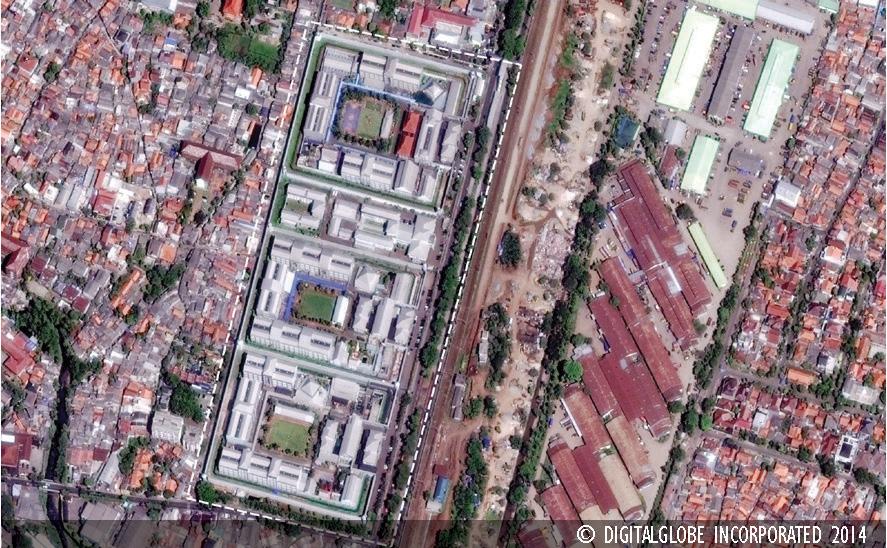














Regardless of your background, education or life experience, you can find a STEM career in Defence
Welcome to the latest edition of Careers with STEM: Defence. At the core of the magazine you’ll find diversity – diversity of background, education, career pathways, life experience and application of critical STEM skills within Defence.
I am pleased to be able to share with you so many different journeys and stories from our people who were only recently students in school or university.

From digital technology and cyber safety to geospatial science, intelligence and physics, this edition is bursting with information and inspiration for anyone who is considering their career options.
One of the many aspects that ties all Defence STEM innovations together is encouraging diversity of thought, which impacts how we, as a very multidisciplinary team, solve the nation’s greatest challenges. Diversity makes us stronger, smarter, and better equipped to tackle the big challenges ahead of us.
In Defence, our STEM professionals work in teams, embracing new ways of working, pushing the boundaries of innovation and tech to solve problems, design and deliver state-ofthe-art solutions to Army, Navy and Air Force.
The Australian Defence Force works closely with our STEM professionals to meet challenging goals, making their work easier and, above all, safer.
Please do keep an eye out in these stories for how people came into their Defence STEM career. Everyone has their own STEM journey,
Tanya Monro Chief Defence Scientist
Diversity makes us stronger, smarter and better equipped for big challenges”
filled with exciting opportunities like work experience, internships, traineeships and graduate programs.
While STEM skills are critical to protecting our nation, non-technical skills are also needed to build the breadth and depth of our STEM talent pipeline. Leadership, understanding how groups function, public speaking and being able to explain complex science to people who don’t have a STEM background are valuable skills that complement technical expertise in putting our nation forward as a leader in Defence.
I hope Careers with STEM: Defence inspires you to chase your STEM dreams.
Professor Tanya Monro AC Chief Defence Scientist
Whatever your interests, there’s a STEM
Careers in Defence are diverse! Whether you’re working with the Australian Defence Force or an Australian Public Service agency like the Defence Science and Technology Group, STEM skills can take you down a career path you may never have imagined.
Combine maths & physics skills with Defence, for example, and you could become a technical intelligence analyst or a geospatial analyst helping defend Australia. Or if you love technology, you could do anything from researching robotics to testing the latest submarines. Into engineering? You could be working on Navy helicopter engines, or running sims on future weapons systems.
In each section of Careers with STEM: Defence you’ll find dream roles, stories of people working in the many different groups that fall under Defence, learn what study or training you’ll need and hear more about the rewarding work you could be doing.
Work with awesome aircraft, and the systems they rely on, help satellites soar or research the latest space technology.
Use the power of data and information to predict and prevent national security threats.
Apprenticeships
Do your trade in Defence, including directly after Year 10, and work on cool gear be it as a mechanic, electrician or technician.


Help create future tech to defend our country. Plus get hands-on with lasers, autonomous vehicles, robots and the latest software.
With maths and physics smarts you could be coding large systems for helicopters, working in explosives, or using medical science to care for ADF members.
Work with the most advanced mechanical equipment you could find, be it repairing military hardware, or ensuring weapons systems run smoothly.


Careers with STEM: Defence is a publication and trademark of Refraction Media. Copyright © 2024 Refraction Media, all rights reserved. No part of this publication may be reproduced in any manner or form without written permission. If you would like to reproduce anything from this magazine, email: info@refractionmedia.com.au.
We acknowledge the Traditional Owners of country throughout Australia and recognise their continuing connection to land, waters and culture. We pay our respects to their Elders past, present and emerging. This issue went to press on 12 September 2024. Printed in Australia by IVE.
Cover image: Kasi Metcalfe Co-founder, CEO & Publisher : Karen Taylor-Brown
Partnerships Manager: Rachel Jones
Managing Editor: Charis Palmer
Deputy Editor: Louise Meers
Sub Editor: Amelia Caddy
Art Director: Katherine Power
Writers: Gemma Chilton, Saskia Horgan-Catchpole, Danielle Lucas, Louise Meers, Charis Palmer

Defence working group: Willliam Sullivan, Liam Brownlie
SUBSCRIBE AND ORDER COPIES: CareerswithSTEM.com /subscribe
EDITORIAL & ADVERTISING ENQUIRIES:
Email: info@refractionmedia.com.au
POSTAL ADDRESS: PO Box 154, Oyster Bay, NSW 2225, Australia CareerswithSTEM.com
ISSN 2209-1076

And get a head start with the Defence STEM Cadetship Program
If you’re still completing your tertiary studies but can’t wait to dive into a role at Defence and keep Australia safe, you should consider becoming a cadet!
The Defence STEM Cadetship Program is for high-performing undergrad students who are currently studying a STEM degree. The program gives cadets practical work experience that links up with their degree. Cadets are also trained by STEM + Defence specialists and will get the chance to provide scientific advice or develop new technologies. — by Louise Meers

Location, location, location
You can undertake this program in Adelaide, Brisbane, Canberra, Melbourne, Newcastle, Perth and Sydney. Live somewhere else? Relocation assistance is available.
Daniel Radiation Scientist, DSTG

fact
When Daniel’s not deepdiving into the latest radiation science, he loves cooking – and is currently working on making the perfect pizza base.
• Competitive part-time salary and benefits
• Flexible work arrangements
• The ability to transfer into to the Defence Graduate Program or progress to a full-time gig once you’ve completed the Defence STEM Cadetship Program
Scan here to find out eligibility requirements and how to apply!


Daniel’s path to Defence started during uni holidays and now he’s building a cool career as a radiation scientist
Asa kid, Daniel always loved STEM – and had a knack for problem-solving (“Mostly with LEGO,” he says).
While studying engineering and science at uni, he joined Defence Science and Technology Group’s (DSTG) 12-week summer vacation placement – a paid program for high-performing STEM undergraduates.
“I wanted to contribute, in my own small way, to our nation’s safety and security,” he says.
Then, the following year, he landed a 12-month STEM cadetship back at DSTG, where he got to really lean into his maths and problem-solving skills. Daniel then joined DSTG full-time the year he graduated, where his job is to test and improve advanced equipment for detecting radiation – making sure systems are working properly.
“It really keeps me excited and focused at work knowing that my outputs are able to support keeping our personnel safe,” he says. – by Gemma Chilton
Interested in working in Defence but want to know what it’s REALLY like first? The Defence Work Experience Program is for you!
Have you heard of the Defence Work Experience Program? It provides young Australians keen on a Defence career the chance to test out what it’s like to work in Defence and learn more about all the epic jobs available in the Australian Defence Force (ADF) and Australian Public Service (APS). All the activities in the program are hands-on and interactive, meaning you’ll have a lot of fun while you decide which Defence role is your perfect fit.
And good news: whether you’re in high school or already studying at uni, there are lots of opportunities available to you. Simply scan the QR code to find work experience placements currently open. As long as you’re 15 years old at the time of placement, you’re good to go! – by Louise Meers

The Defence Science and Technology Group (DSTG) runs this week-long event to show off its STEM careers, plus those with industry partners.
In STEM Immersion Week, you’ll get insights into how DSTG applies research in the engineering and science fields. You’ll also meet Defence scientists and engineers who will tell you all about what they do in their jobs and how they develop new capabilities for Defence.
During the program you’ll tour DSTG’s research facilities and get a close-up look at equipment that isn’t normally open to the public. This might include everything from undersea surveillance equipment to navigation tech!

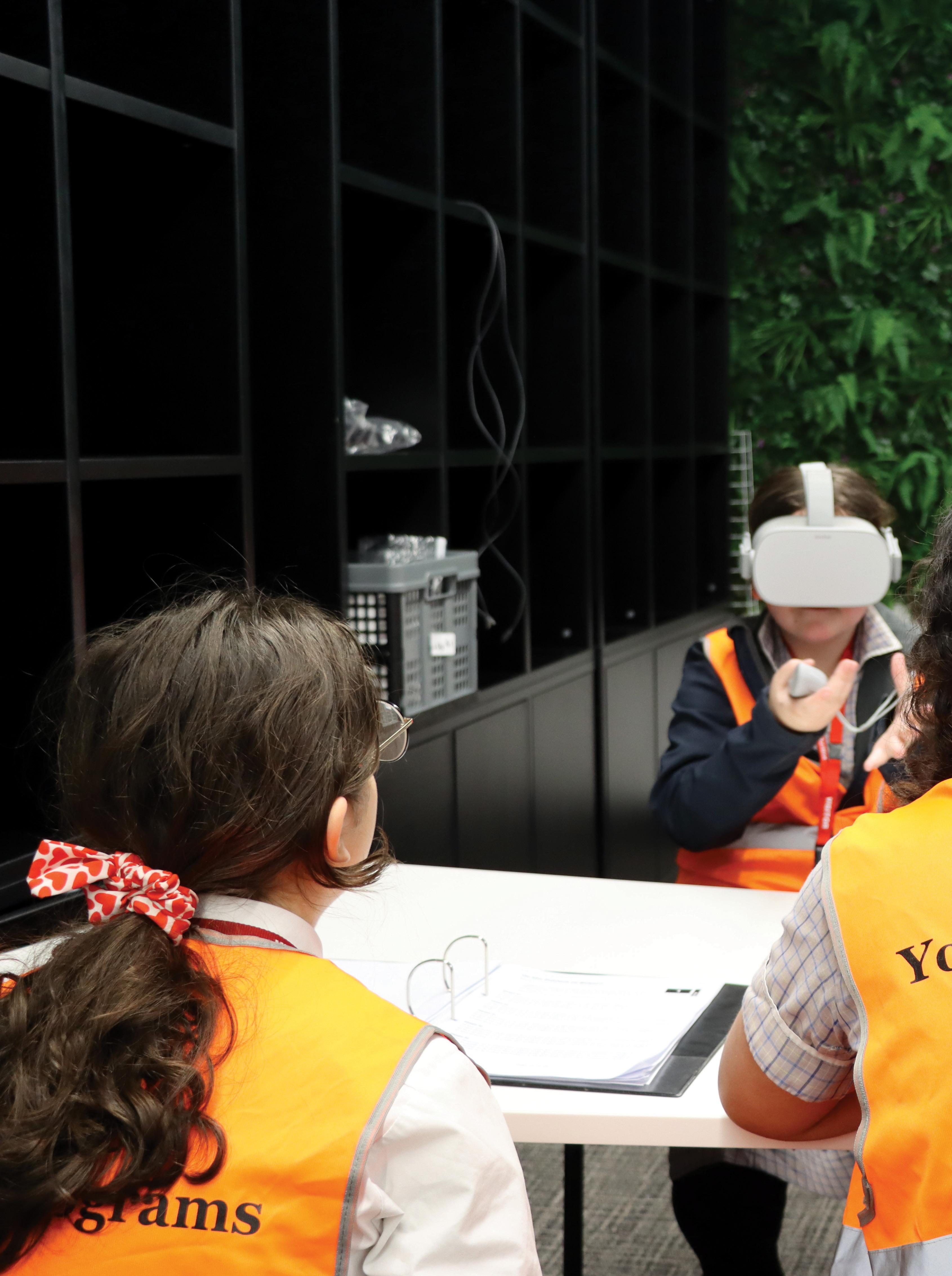
Types of placements
Here are some examples of areas you could gain experience in:
• Aviation
• Communications, IT and intelligence
• Cyber security and robotics
• Engineering
• aviation science
• Science
• Trades, including mechanics and electronics

• The Defence Work Experience Program is run nationally for secondary and tertiary students
• The program also provides opportunities for female students, Aboriginal and Torres Strait Islander students, students from culturally and linguistically diverse backgrounds and students studying STEMrelated disciplines to engage with Defence.
• Its goal is to help ease the transition of young people into the workplace and showcase Defence careers.
Check out some of the incredible opportunities the Defence Work Experience Program has provided students!
In April 2024, the Defence Work Experience Program in Western Australia hosted 14 students at HMAS Stirling. HMAS Stirling is home to Australia’s six Collins-class submarines and students had the opportunity to talk to submariners and learn about their jobs. The highlight was a visit to HMAS Waller where students got a tour of the submarine by experts in electronics engineering, marine, electronic technician and general submariner roles. Students also saw how submariners are trained and learnt about the different systems inside a submarine, how they work and how they’re maintained.
Electronics Engineer
Submariner
The Navy’s electronics and combat systems engineering experts are responsible for the maintenance and repair of communications, sonar, navigation, combat data, fire control and weapons systems on submarines.
Electronics Technician
Submariner
Responsible for the performance of underwater sensors, combat and weapons systems, navigation aids, electronic warfare systems and more.
Marine Technician
Submariner
This role is split into two trade specialisations: electrical and propulsion.
Marine Technician
Submariner – Electrical
On International Women’s Day, the Land Engineering Agency’s Monegeetta Proving Ground held a special event for students, inspiring young women to consider study paths that lead to STEM careers. Students met senior Defence leaders, including Sarah Myers, Assistant Secretary Armoured Fighting Vehicles, and Fiona Ince, Senior Specialist Engineer, plus ADF representatives. They also got hands-on at the Testing Laboratories with 3D scanners, night and thermal vision goggles, clothing development, hot and cold chambers and vehicles.
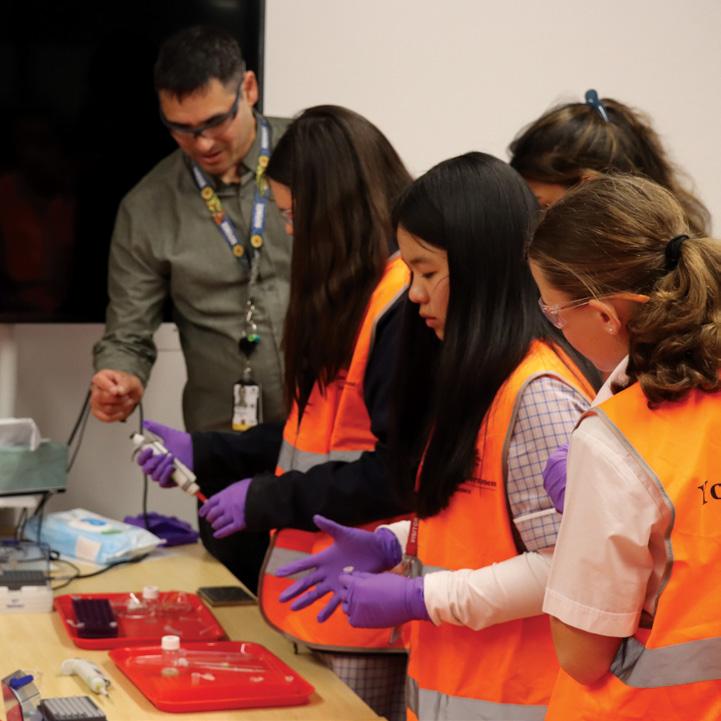
Maintain and operate the submarine’s electrical systems, including hydraulic systems, refrigeration systems, and electrical power generation, storage and distribution.
Marine Technician
Submariner – Propulsion
Operate machinery and maintain propulsion and auxiliary systems, working with hydraulic systems, engines and weapon discharge systems.


Not sure what to do after high school? Defence offers options for everyone, be it for a gap year or as a way to go to uni while being paid
Working out your career path after school can sometimes feel like standing at a crossroads without a map. Luckily, Defence has a GPS! If you’re torn between uni, trade school or just taking off to travel, check out Celenia’s story below for inspiration.
Aside from general entry options or going straight to the Australian Defence Force Academy (ADFA) to get your degree, Defence offers a gap year program for Year 12 grads. It’s a great way to get a feel for what a career in the Navy, Army or Air Force would actually be like. Plus, you could learn some sweet life skills, make new friends and develop


other ADF entry options
There are several ways to join the Navy, Army or Air Force with many roles offering more than one entry method. These include General Entry, Qualified Entry, Officer Entry and Defence University Sponsorship. choose your path
For help to choose the best option for you visit www.adfcareers.gov.au
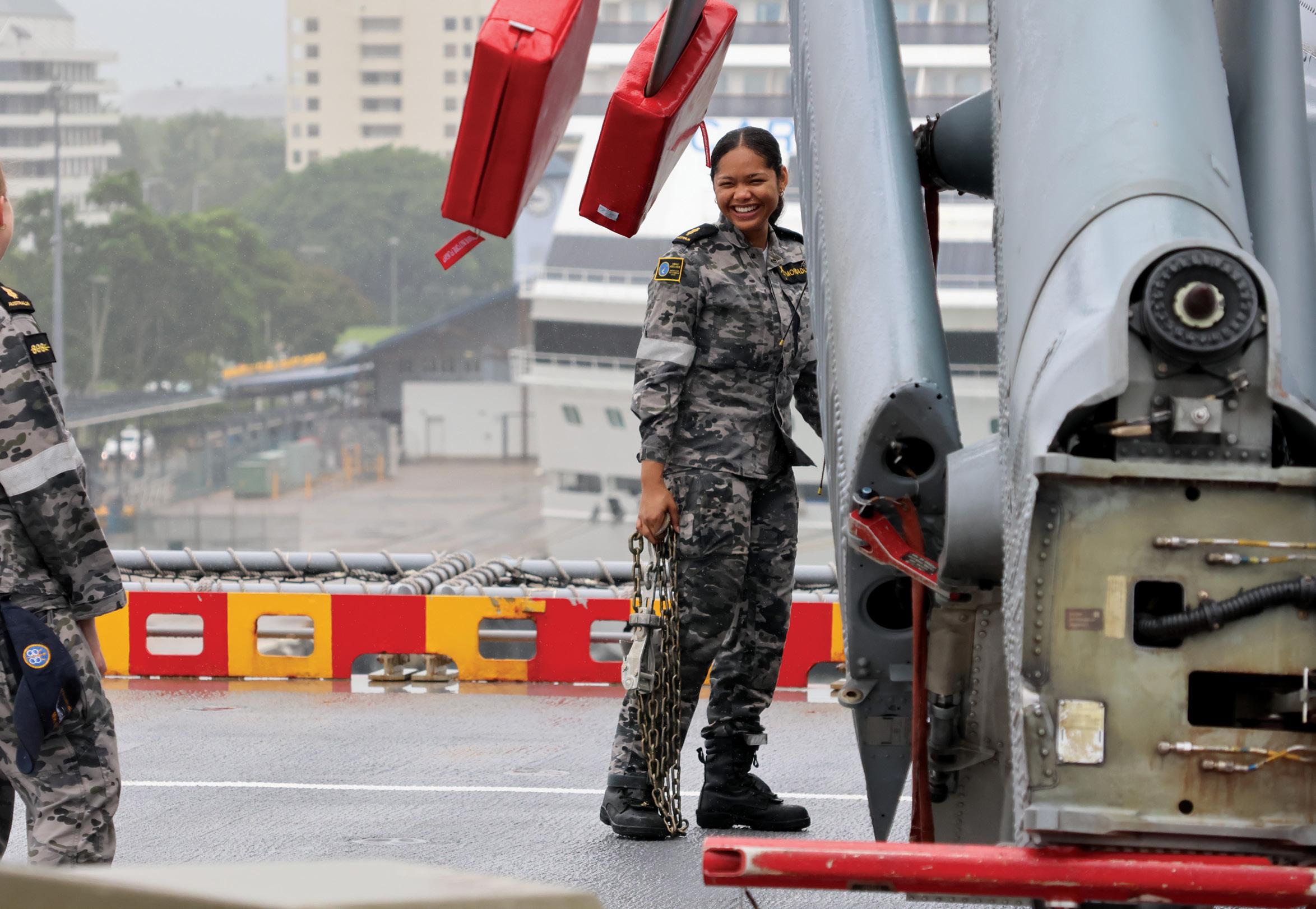
Celenia was tossing up between uni or a trade qualification and found a happy medium with Defence
When graduating high school at age 17, Celenia wasn’t sure whether she’d prefer uni or a trade, but she did know she wanted a mix of mechanical and physical.
As an aviation technician in the Navy, Celenia has hit on a career combining the best of both worlds.
She picked the Navy for the travel opportunities and aviation to fast-track her education with a view to one day working in the civil aviation industry.
“What I wasn’t expecting was to make mates for life, not only from Australia but from all around the world,” Celenia says.
Her job involves maintaining the MH-60R Seahawk helicopters at 808 Squadron. This includes maintaining fuel, hydraulic and flight control systems.
Celenia says she’s had some great female mentors helping her to navigate the aviation industry and find a good work-life balance, and she’d love to see more women joining aviation. – by Charis Palmer

my outputs are able to support keeping our personnel safe”
The Defence Force needs more people working in aerospace engineering. Are you ready for an out-of-this-world career?
Fascinated by how things work? Passionate about all things space? Naturally curious and want a job that involves advanced tech but also makes a difference? If this sounds like you then you should definitely consider aerospace engineering in the Defence Force.
It’s a super-exciting time to jump on this path. The Australian Government is investing $7 billion in Defence’s space capabilities this decade, with the aim to assure access to space, space services and geospatial information. This means there’ll be plenty of career opportunities. You could work on new and innovative aircraft design, electrical, navigation and communication systems, software, and so much more. The sky is NOT the limit here! – by Louise Meers
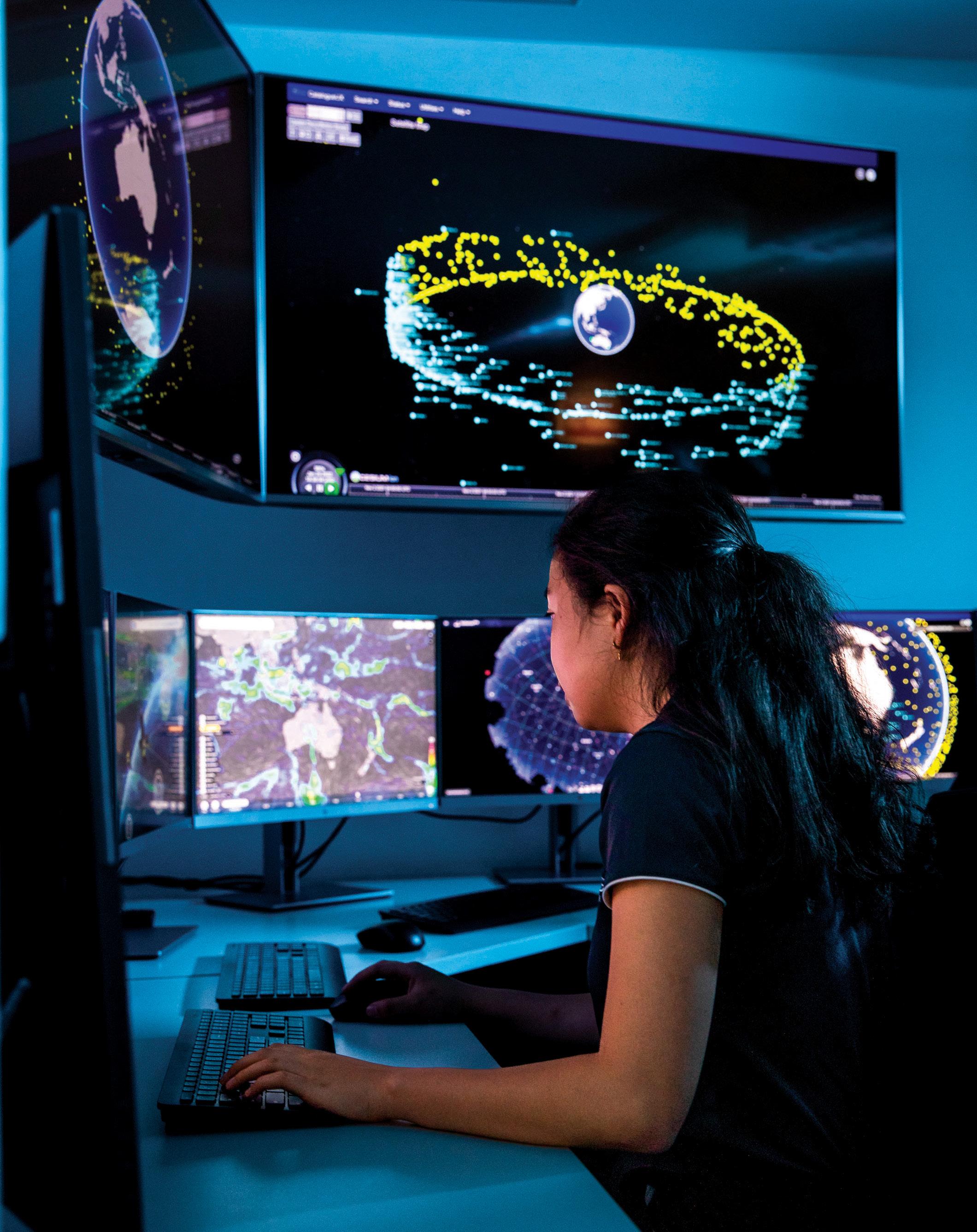

Check out three aerospace engineering roles you could score in Defence + Aerospace Engineering:
Navy Aerospace Engineer Officer
The job: You’ll get to work with and maintain Navy helicopters and sharpen your understanding of their structures, engines, aerodynamics and weapons systems. Making sure aircrew have safe and capable aircraft for operations and missions will be your number-one goal.
The perks: All of the opportunities for career progression and adventure!
Army Aerospace Software Engineer
The job: This one is all about managing software for really awesome aircraft. You’ll get to design, construct and test large-scale software systems that support helicopters like the Black Hawk, Chinook and Taipan!
You’ll love it if: You want a career that involves tech, engineering and aircraft, plus one that’ll challenge you!
Air Force Aeronautical Engineer
The job: Be at the frontline of maintaining aircraft structures, propulsion systems and related ground support systems, working at the leading edge of aircraft technology.
You’ll love it if: You want to work on real aircraft, gain engineering and leadership experience and be supported by an awesome team of experts.
Captain Matt’s passion for aviation led to an engineering career working with Army helicopters
Whenhis hometown of Bundaberg suffered one of the worst floods in its history, just two years after another major flood, Matt decided to join the Army. He was inspired by seeing Black Hawk helicopters rescuing people stranded on their rooftops, and was motivated to enlist.
“Seeing the skill and the willingness to do something difficult while being professional was something that I wanted to be a part of,” he says.
Now, as an aircraft project engineer in the Army, Matt’s had some awesome experiences – such as being involved in night missions to refuel helicopters, leading an Aircraft Repair Troop, and helping introduce the public to Army aviation at the Australian International Airshow. He says working with the Apache helicopters has been his coolest experience so far.

ApacheProjectHelicopter Deputy
ProjectManager,Engineering Army

Maths is literally everywhere, you’re doing it all the time”
Growing up, Matt always knew he wanted to work in a technical job but he doubted his abilities, especially in maths. “I lost interest in my senior years of high school because I couldn’t see where maths was used in real life,” he explains. “But it’s literally everywhere, you’re doing it all the time. Once I understood that, I wanted to learn everything I could.”
Beginning his career as an aircraft mechanic with basic maths skills, his passion for flying led him to study aerodynamics. He’s now on his way to a PhD. Matt's biggest hurdle was working out how he learnt best. “Engineering is hard. It took me a while to figure out what learning processes worked for me,” he says. “But anything worthwhile isn’t easy and aeronautical engineering was worth it to me.”
One thing that does come easily for Matt is his love for aviation. With exciting projects on the horizon, including assisting with airflow modelling on Navy ships where the Apache helicopters operate, Matt’s contributions to the field continue to soar to new heights. – by Danielle Lucas

From helping design spacecraft to working with rockets, Harrison is fulfilling a dream to use his engineering skills to make an impact
Imagine working with vehicles that move so fast they can heat up to more than 3000°C! It’s all in a day's work for aerospace engineer Harrison. His job at the Defence Science and Technology Group (DSTG) is to design new structures and materials that can handle this incredible heat.
“It’s a challenge, but together with an awesome team (spread across Australia), we’re pushing the limits of what’s possible,” Harrison says.
Harrison always wanted to do something with STEM, and at uni he sought out opportunities in aerospace engineering including internships, along with lots of extracurricular projects. “They were a fantastic way to explore different areas of STEM and hone my skills and interests,” Harrison says.
During an internship at Boeing, he helped design a new concept for a Lunar Terrain Vehicle as part of the NASA Artemis missions, a project which he says strengthened his skills in research and development.
Harrison joined Defence as part of the Defence Graduate Program, hoping to use his engineering skills for something truly impactful.

i'm constantly learning and growing”

“Now, I feel like I’m applying everything I’ve learnt to projects that are pushing the boundaries and making a real difference. That’s incredibly motivating. I’m constantly learning and growing, but I’ve reached a point where I can contribute meaningfully to groundbreaking projects. It’s incredibly humbling and rewarding to be a part of something bigger than myself,” he says.
“It might sound simple, but being a quick learner and adaptable are crucial in this field. Things change fast, and being able to roll with the punches and learn new things on the fly is key,” Harrison adds.
“And remember, STEM is huge! There’s a place for everyone. So, keep an open mind, explore different areas and see what sparks your passion.”
– by Charis Palmer
Researcher Jemma is helping Defence find new ways to generate power, with an awesome team of people
Drawnto Defence by the opportunity to help the country while working on interesting and important projects, Jemma is now using her STEM skills in a really useful way – working on the future of power generation.
As a researcher with Defence Science and Technology Group (DSTG), Jemma works on producing power from otherwise neglected potential sources. This includes researching avenues of waste heat recovery, modelling and testing possible options to incorporate into existing engines, and even exploring the possibility of harvesting energy from the ocean!
“In 2024, I am looking to develop a test rig to further my research into a wave energy converter system. It’s exciting to put my model into practice,” Jemma says.

Research Engineer, DSTG

In her incredibly rewarding role, Jemma says she’s been able to develop her knowledge in many different areas with the help of a really supportive team.
“I have learnt during my time at Defence that no project contains only one discipline of engineering, and to build any substantial project combines a mixture of several. This means teamwork is essential and there is always more to learn,” Jemma says.
“Working in STEM, and specifically working for Defence, is an incredible journey, so don’t give up. If you find something challenging, there is always someone who is willing to help – as long as you ask.”
–
by Charis Palmer
Working for Defence is an incredible journey”
Discover a career where your passion for tech and making a difference can shape – and protect – Australia’s future
Acareer in Defence + Intelligence & Data means using the power of data and information to predict and prevent national security threats. It’s a growing field always looking for curious, STEM-skilled people who love tackling complex problems and are passionate about making a real-world impact. – by Gemma Chilton
where could you work?
Check out these key agencies where you might land your dream job.
Defence Intelligence Organisation (DIO) Analyse complex information to protect Australia.
Defence Digital Group (DDG) Use cutting-edge tech to support Defence.

13,000
The number of cyber security jobs open in Australia right now!
Some of the cool roles you could do!
Technical Intelligence Analyst Turn top-secret technical information into useful insights to keep Australia safe.
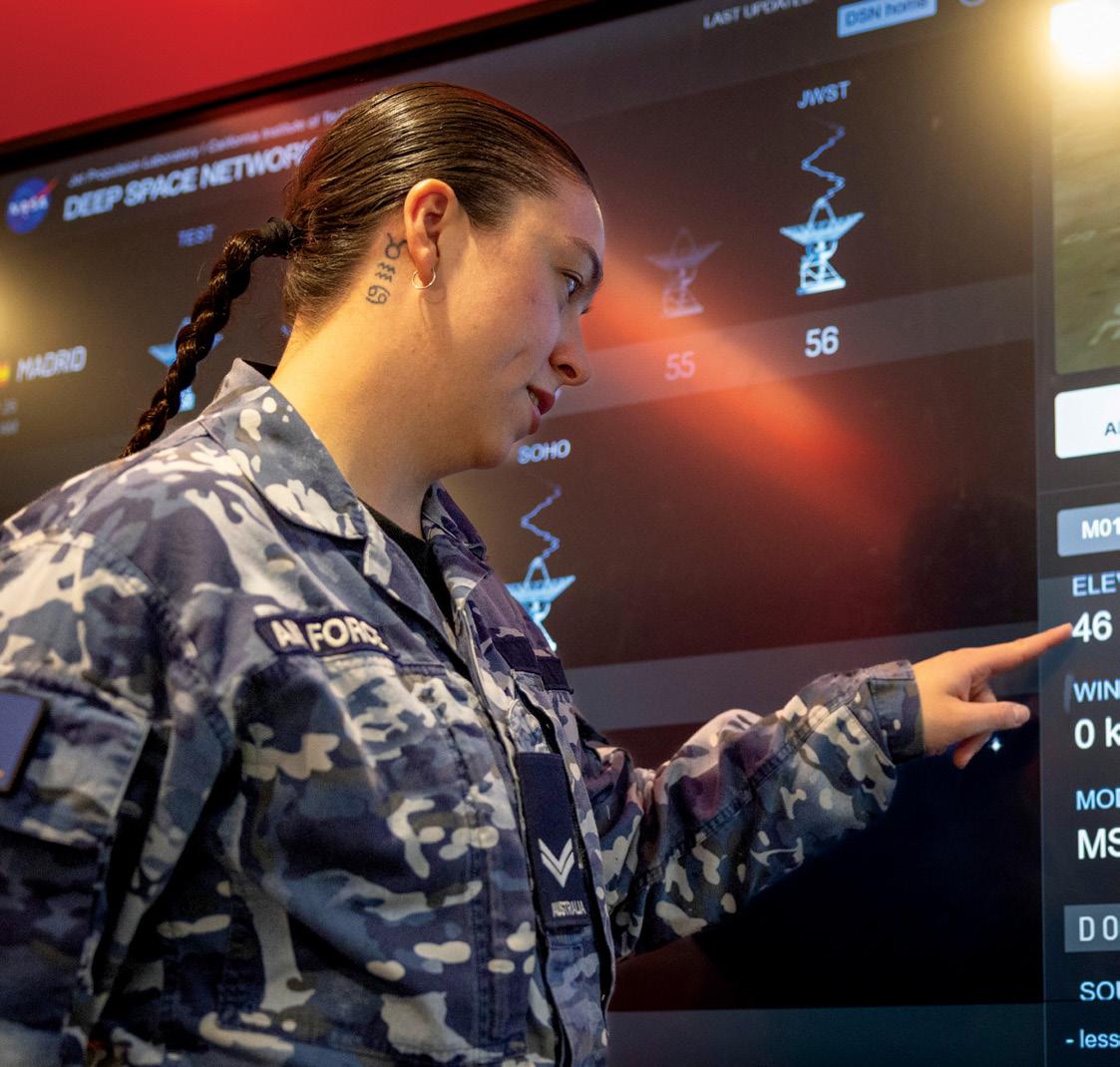
Defence Science and Technology Group (DSTG) Utilise complex data and HighPerformance Computing to solve problems for Defence.
Australian Signals Directorate (ASD) Outsmart hackers and secure digital spaces.
Australian GeospatialIntelligence Organisation (AGO) Turn images from space into intelligence.
Australian Cyber Security Centre (ACSC) Help protect Australians from digital threats.
ROYAL AUSTRALIAN AIR FORCE CORPORAL ALLISON, AN INTELLIGENCE ANALYST AT SPACE COMMAND, AT THE SPACE COMMAND OFFICES, CANBERRA.
Cybersecurity Specialist Battle hackers and protect our digital world.
Data Scientist Find patterns in data to help make big decisions.
Digital ConsultantTransformation Help Defence use tech to stay ahead.
Corporate and Policy Analyst Work out the best rules and strategy for Defence to follow.
These skills and traits are super valuable in this line of work!
✔ Problem-solving
✔ Tech-smarts
✔ Creativity
✔ Great communicator
✔ An eye for detail
Generalist Analyst Use your STEM skills to team up wth the best strategists on critical security topics.
Geospatial Data Analyst Use AI and machine learning to manipulate geospatial data in support of answering intelligence questions.
Geospatial Intelligence Analyst Use satellite photos and maps to answer important security questions.
Cyber AnalystIntelligence Hunt for digital clues to stop cyber threats.
Signals SpecialistIntelligence Listen in on electronic signals to gather secret intel.
With
Asa provider of intelligence to the Minister of Defence and senior Defence officers, the Defence Intelligence Organisation (DIO) is like the ultimate wingman to the Australian Defence Force. And it takes some serious STEM skills to deliver.
In fact, the DIO employs people from more than 80 STEM disciplines, meaning there are plenty of pathways to work there. As a STEM analyst with DIO you’ll get to flex your STEM skills evaluating available data on weapons systems and defence-related technologies.
As a technical intelligence analyst, you could combine STEM with another discipline, like physics and international relations graduate Alex (page 30). Or use engineering and science to analyse weapons systems, like Toni (page 18).
Kei (page 17) combines materials engineering and science skills to advise on Defence-related technologies. – by Charis Palmer
Choose your STEM flavour combo
Here are just a few of the combinations you’ll find in DIO analysts
Science (Physics) + Arts (International Relations)
Materials Engineering + Science
Aerospace Engineering
+ Mechanical Engineering
Computer Engineering + Science
+ INTELLIGENCE &
+ STUDY
Bachelor of Engineering
Bachelor of Physics
Bachelor of Science
Bachelor of Mathematics
Dual degrees and higher qualifications like Honours and PhDs are highly valued but not essential.
DEFENCE + INTELLIGENCE & DATA + JOBS
Technical Intelligence Analyst
STEM Analyst Policy Analyst
DIO ENTRY LEVEL PATHWAYS
Defence STEM Cadetship Program
Join as a STEM Cadet, get paid for work experience during breaks while you study, tuition and books paid, and guaranteed employment on successful completion of your degree.

Defence Graduate ProgramIntelligence pathway (with STEM)
Join Intelligence pathway graduate programs for DIO and get a full-time job while you undergo training and professional development.
As a technical analyst, Tarun informs senior government decision makers on weapons systems that pose a threat to the Australian Defence Force
Fascinated by space, physics and engineering, Tarun dreamt of a career that was meaningful and incorporated his passions. He’s found all that and more as a technical analyst at the Australian Geospatial- Intelligence Organisation (AGO).
Tarun uses cutting-edge tech to provide Defence with intelligence on weapons systems and other technologies of potential adversaries. As a technical analyst, Tarun works with international partners on projects that have a very real impact on Defence operations.
“Working in Defence, I’ve found a job I am excited to do. Plus there are so many training opportunities if you choose to take them,” Tarun says.
His advice to those looking for a career they love in STEM? “Go for it! You don’t have to have the best grades in school to pursue a career in STEM or Defence. It’s more important to be curious, have a willingness to learn and take interest in the work you do.”
– by Saskia Horgan-Catchpole
australian geospatial intelligence organisation (AGO)
AGO is the lead agency for geospatial data, information and intelligence for Defence and the National Intelligence Community. Read more about them on page 31.

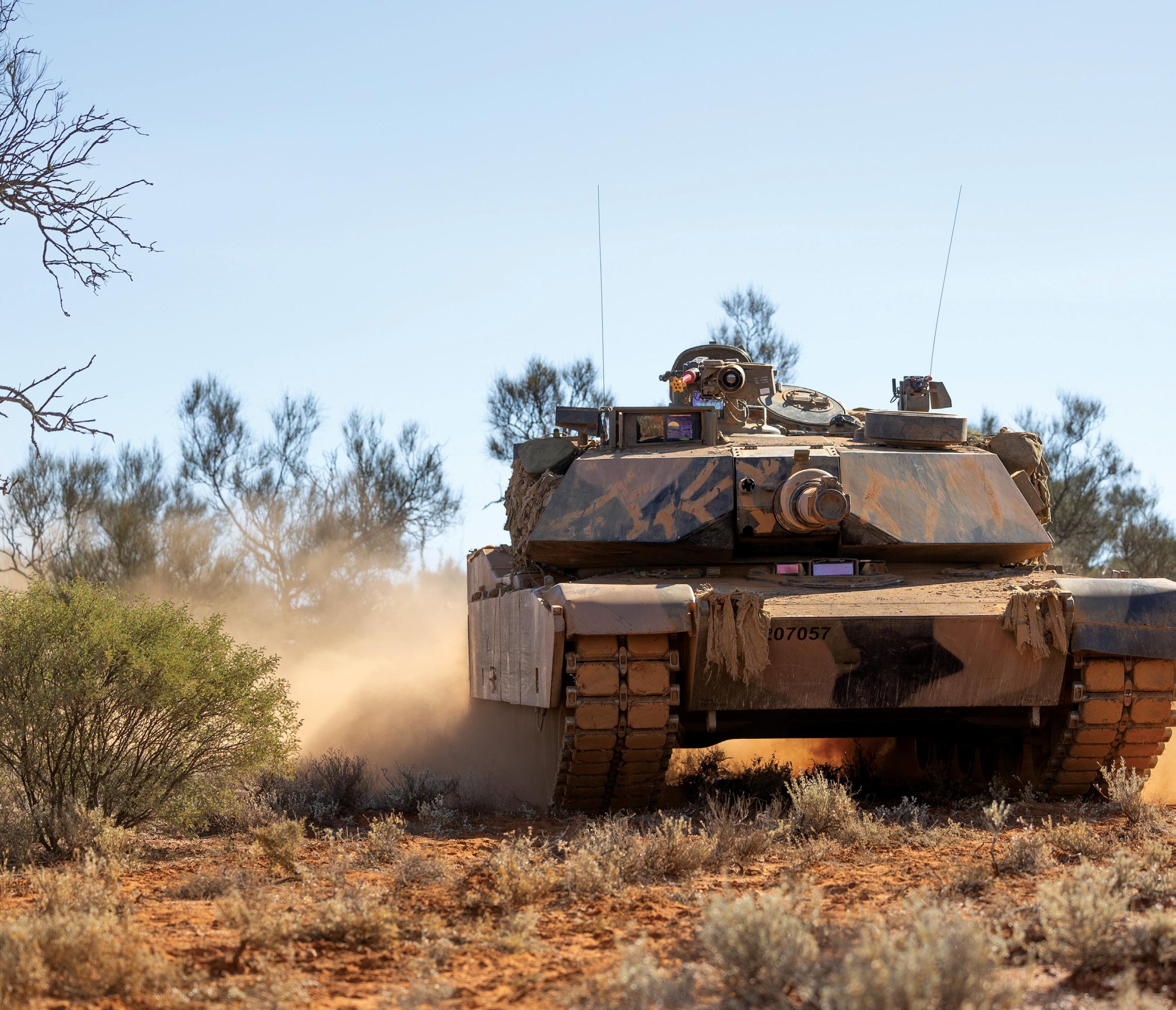
Sam studied aerospace engineering at uni, worked for a Defence contractor and now says she has the best job in the world at the Defence Intelligence Organisation (DIO) we picked her brain about her STEM + Defence journey
CwS: Why STEM?
A: I’ve always been interested in STEM; the idea of being able to make anything you can imagine has always fascinated me, and is made possible with STEM.

CwS: Best thing about your job?
A: The modelling projects are really cool and difficult. The challenge comes from developing a model with only half the information you need. I use my engineering background to find different sources and my analyst training to weigh up which sources and answers best fit the scenario/criteria that I’m trying to model for. Plus I get to travel a lot!
CwS: What’s your advice for young people who want to learn about and pursue a career in STEM and Defence?
A: Join your university’s rocketry, solar car or any other engineering school-based team. You will make friends, connections, and practise what you’ve learnt at university. – by Louise Meers
Kei’s tech skills help the Australian Defence Force make important decisions

Jumping on a Defence path while still at uni, Kei did the Defence Engineering Internship Program and then conducted research projects with the Defence Science and Technology Group (DSTG).
Now as a technical intelligence analyst at the Defence Intelligence Organisation (DIO), he evaluates Defence-related technologies and compiles threat assessments for the Australian Defence Force.

“Our motto is to save lives, protect platforms and prevent surprises,” Kei says. “Recent conflicts highlight the rapidly expanding number and variety of potential threats that Defence faces and reflects the growing scope of technologies that we cover.”
“Due to security, we don’t always know how our threat assessments may shape decision making. But the most rewarding projects are always when those who are using your assessments come back to say how your advice
made a difference,” Kei adds.
For anyone considering a tech + Defence career path, Kei believes you should get hands-on with STEM at home. You can gain practical skills with 3D printer kits, robotics projects and Raspberry Pi.
And at uni? “Joining student design teams such as high-powered rocketry or motorsport can develop these skills further.” – by Louise
Meers
Kei owns seven 3D printers, five of which he says are now just ‘display pieces’, proving just how hard it can be to stay up to date with the best technology!
After studying aerospace engineering at uni, Toni now analyses weapons systems potentially aimed at the Australian Defence Force
It is never too early in your STEM degree to apply for the STEM Cadetship – I applied before I was even halfway through!
MINISTER FOR DEFENCE INDUSTRY, MINISTER FOR INTERNATIONAL DEVELOPMENT AND THE PACIFIC, THE HON PAT CONROY MP DISCUSS WITH MR ROSS OSBORNE – CHIEF ENGINEER (SYPAQ) AND CEO SYPAQ, AMANDA HOLT DURING THE ANNOUNCEMENT OF DEF 129, DELIVER SMALL UNCREWED AERIAL SYSTEMS AT SYPAQ SYSTEMS FACILITY, MELBOURNE, VICTORIA.

At the Defence Intelligence Organisation (DIO), Toni works to predict which weapons could be used against the Australian Defence Force (ADF) with limited information – using scientific evidence and engineering to make up the difference!
“I work within the Weapons and Technical Intelligence Branch to characterise advanced weapons systems which could be used against the Australian Defence Force,” Toni says.

“We combine engineering principles and methods with analytical techniques and construct advanced computational models.”
Toni was born into a family of Defence people (with uncles who served as RADAR operators) and she has always loved aerospace engineering, especially the high-speed factor!
Halfway through her uni studies, Toni applied for the Defence STEM Cadetship program, which was

a great way to get experience in a real-world environment.
“At the DIO there is a deep training pipeline – new starters get all of the training they need to be successful,” Toni says.
“You also quickly learn to work in a hybrid environment as the Australian Public Service and uniformed Defence force members work together in teams across the organisation,” she adds.
She's always had a supportive team and lots of young people in the office to hang out with.
"If you want to know what kind of interesting work lies in a career in Defence," Toni says, "come work with us and find out!" – by Saskia Horgan-Catchpole
Jordan Forensic scientist

Jordan always had an interest in crime-scene forensics, and thanks to her career in Defence she now gets to investigate for a living
If CSI is your thing then you’ll love Jordan’s career path! As a forensic scientist in the Army, Jordan investigates serious crimes within the Australian Defence Force.
To get there, Jordan studied a Diploma of Forensic Investigations through Defence, meaning she’s now qualified to dig into crime scenes, gathering evidence as a ‘Scene of Crime Examiner’.
“No day is exactly the same and at times you have to think on your feet,” Jordan says of her role.
“There is a lot you can learn from evidence found at a crime scene and it can help piece together what truly occurred.”
Jordan joined Defence “to be a part of something bigger than myself” and says it has also offered her so many opportunities to skill up in her chosen area, make friends and build a support network.
Don’t be scared of doing what you enjoy”
Many of Jordan’s new friends have come through Defence Sport.
“I have played for both Army AFL and ADF AFL. This experience and being a part of these teams has developed me both professionally and personally,” Jordan says. “I have made lifelong friends that are also members within Defence so we share the same values and humour.”
In 2020, Jordan was deployed to Afghanistan and got to meet and work alongside members of the military from other nations, which she says has been one of the highlights of her career so far.
Jordan’s advice to young people considering a STEM career in Defence is: “Give it a go!”
“The first step is always the hardest so don’t be afraid to try new things and be outside of your comfort zone. That’s where you grow." – by Charis Palmer
hands-on work + STEM = an exciting Defence career!
Get started with an Australian Defence Force apprenticeship
Handle and maintain armament systems, ejection seat systems and air-launched munitions. Oh, and work with the world’s most advanced weaponised aircraft and their systems!
Inspect,
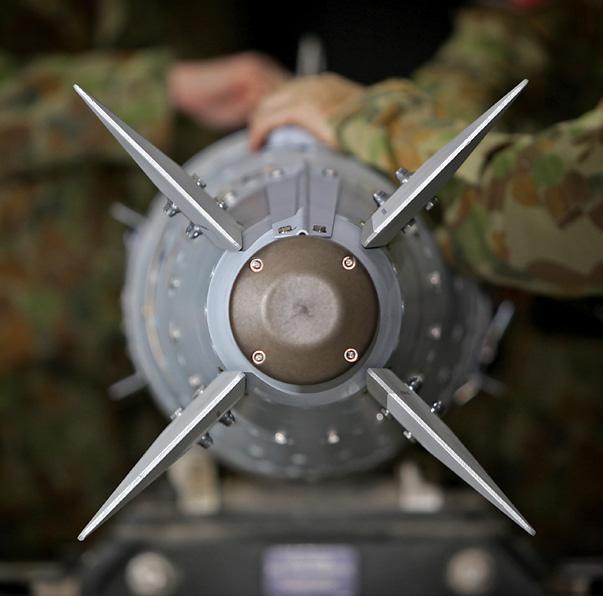
Work with advanced communication and surveillance tech, plus maintain and repair aviation support systems for the Air Force to keep the skies safe!
Tackle plumbing projects on base, on exercises and on deployments to provide clean water to the Army and local communities.
Maintain the systems and components that turn an ordinary aircraft into a military helicopter.
As a fitter in the Air Force, Ethan gets to apply his love for engineering to looking after some very intricate tech
Whenit comes to being a fitter, the stuff you get to work on doesn’t get more interesting than in the Air Force. Every day Ethan is repairing, modifying or refurbishing the gear used by Air Force personnel, be it aircraft maintenance jigs, small engines or even small arms weapon systems.
Ethan was always keen on engineering for the opportunities it offers to work on intricate technology and do complex problem-solving. But he chose Defence for the opportunity to travel.
“Every day I’m faced with a new challenge and I am always learning something new,” Ethan says. Like learning skills in 3D printing, CAD software and CNC cutting machines.
“Don’t deny an opportunity to pursue a career through Defence, the opportunities are unmatched and all the people that you meet will be your friends for life,” Ethan says. – by Charis Palmer


Maintain advanced weapons systems, communications, fire control and combat management systems.

Fully-funded scholarship places to study a trade at TAFE are available for women who have just finished school, are returning to work or are seeking a career change.
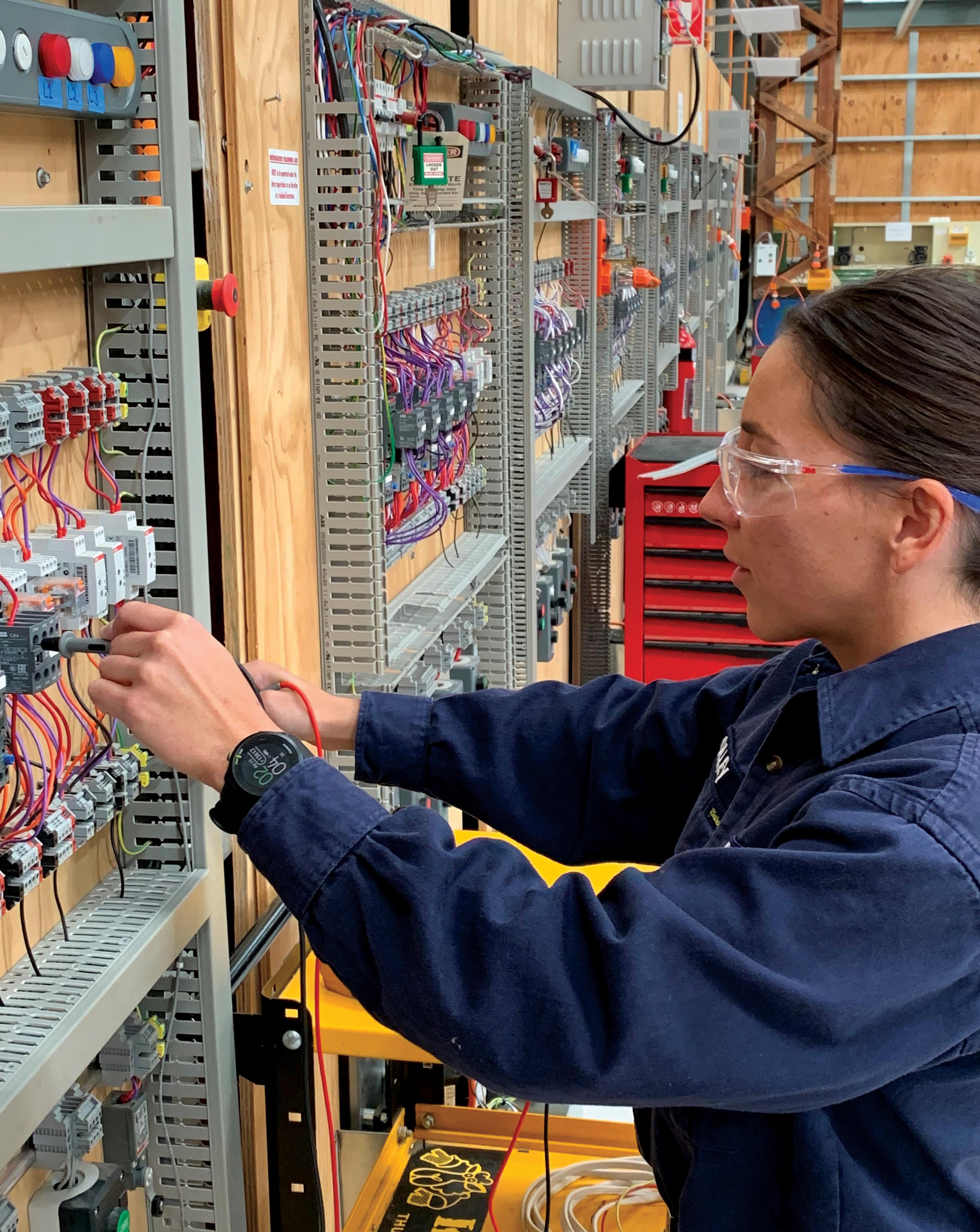
Apprentice electrician Sheree switched from nursing to Defence to fulfil a lifelong dream to do an electrical trade
Before joining Defence, Sheree was a nurse, but she was always interested in engineering and electrical work. Now she’s underway with an apprenticeship in the Air Force and looking forward to a career as an electrician.
“Defence offered me the mentally diverse and physical side of work I was looking for,” Sheree says.
“I like to be challenged mentally and physically. I knew that within Defence and the job role, I could achieve both and have longevity within my career.”
On a typical day, Sheree instals, maintains and repairs electrical components, often having to figure

out why something isn’t working. “And learning about how electricity actually works and connects – which isn’t just flicking a switch and everything magically turns on apparently,” Sheree jokes.
She appreciates the camaraderie that comes with working in Defence, be it on regular tasks or in field exercises and competitions.
During her recruitment, Sheree was enrolled in a Women in Defence program with like-minded women also keen on joining Defence. The program helped her gain the physical fitness required to pass fitness tests, like scaling 4-metre walls! – by Charis Palmer
Defence offered me the mentally diverse and physical side of work I was looking for”
Live and breathe all things technology? Defence needs you!
Creating future tech is no easy feat, which is why Defence needs people skilled up in STEM to join them. You could work on laser and radar technology for advanced threat detection, AI projects, autonomous vehicles, blast-proof materials, acoustic imaging on submarines, satellites, drones, and more.
And not only would you be part of a team of bright minds creating cutting-edge technology, but you’d also be making sure Navy, Army and Air Force personnel are equipped with everything they need to defend Australia, and stay safe while doing so. – by Louise
Meers

Asa child, Ally dreamed of becoming a classical pianist, but as she got older she realised she enjoyed exploring new things, especially in STEM.
While studying engineering at uni, Ally secured a Defence Science and Technology Group (DSTG) placement that helped set the course of her career. “The Industry Experience Placement helped me decide to pursue a Defence career due to the variety of challenging but interesting research projects they offered,” she says.
At DSTG, Ally works with robots, testing algorithms in simulations. “It’s an extra check before putting it straight onto real robots. It’s done as insurance – it’s better than damaging our cool robots!”
Tackling research projects is what Ally loves most about her job. “It’s often challenging,” she says, “but the learning is guided by senior researchers, making it less stressful.” — by Danielle Lucas
check these out
Programs that’ll help you land a tech career in Defence
Digital Cadet Program
Open to those studying an undergraduate or postgraduate degree in a digital or technology-related field. You could be placed with the Department of Defence and work in areas like networking, infrastructure support and software engineering.
Defence Graduate Program Research and Innovation Stream
A 12-month program where you’ll get to see what it’s like to work at DSTG, learn on-the-job skills and score an ongoing role upon completion.
Find out more about this program



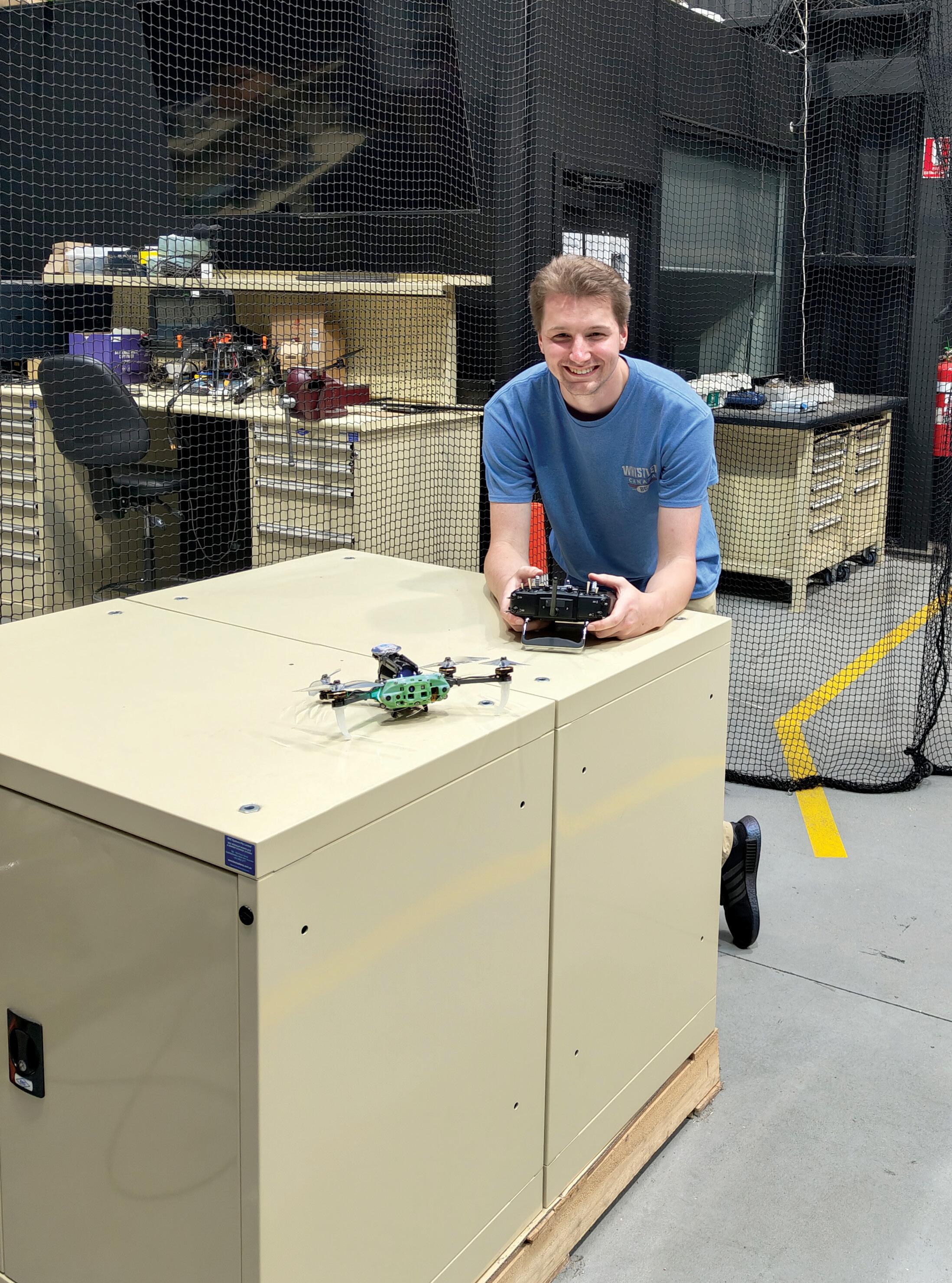
Simon’s tech journey began early, fuelled by a fascination for robotics. Growing up, he pulled apart remote-control cars, built robots with Australian Geographic kits and LEGO Mindstorms, and crafted his own solar-powered car. This passion for hands-on experimentation even extended to coding apps on a Raspberry Pi.
“I think what drew me to engineering was the problem-solving nature of the work,” he says.
“I had always been curious about how and why things worked, or often more importantly, why things didn’t work.”
Now, as a robotics research engineer with Defence Science and Technology Group (DSTG), Simon uses this curiosity every day. His job involves putting cutting-edge tech into platforms, like adding advanced computer vision programs to drones. He handles everything from setting up the hardware and running the algorithms to processing the data and making sense of it.
“The best thing is working with cutting-edge hardware and systems that would be hard to access outside of Defence,” Simon explains. “I get to test software-based solutions on hardware
of Information Technology Bachelor of Engineering (Electrical) Bachelor of Engineering (Mechanical)
Bachelor of Engineering (Aerospace)
Bachelor of Science (Physics)
every day. Watching something that previously only existed on a computer have a real, practical impact is really cool.”
During his university studies, he participated in DSTG’s Industry Experience Program and STEM Cadetship Program, paving the way for his current role. His advice to others is to get involved in these programs yourself. “It lets you experience the various different paths of Defence and find what is suited to you,” he says.
Simon’s favourite project in his career so far was Exercise Trident 2022, where he worked with the ADF on a ‘robots first’ approach to a potentially hazardous area. Getting his remote pilot's license is another highlight, and if these achievements are anything to go by, his future is looking pretty awesome. – by Danielle Lucas
DSTG Systems Safety Manager
DSTG Technical Officer - Avionics or Electrical Technician/Aircraft Maintenance Engineer
DSTG Technical Specialist
DSTG Project Systems Engineer
If you want to help Defence fight and win in the digital age, join the Defence Digital Group!
of working in tech some day? You should put that passion
(and your amazing STEM skills!) to good use in a role at the Defence Digital Group (DDG). DDG works on information and communications technology (ICT) to help Defence in areas like intelligence, surveillance, communications, information warfare, command and management.
DDG needs people keen on tech to join their mission. On this page, explore awesome careers at DDG that will have you coming up with digital solutions to warfighting problems, as well as building new digital systems to make sure Defence has a dependable, secure, and integrated information environment to operate in. – by Louise
Meers
Good to know
DDG offers on- and off-the-job training and the opportunity to work with industry leaders! Find out more: bit.ly/ DigitalDefenceGroup
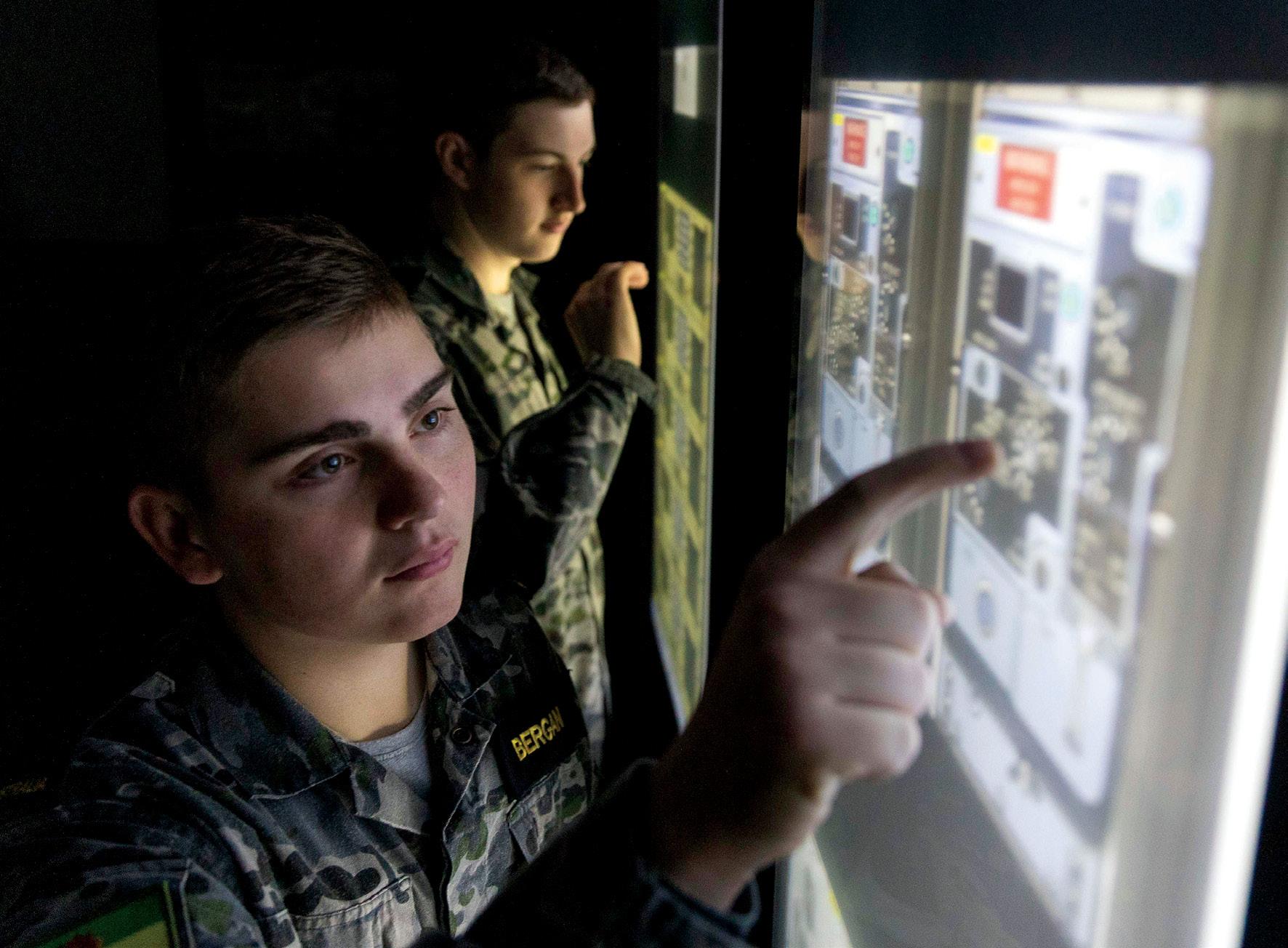
COMMUNICATION INFORMATION SYSTEM - INFORMATION SPECIALIST KYLE (LEFT) AND SEAMAN COMMUNICATION INFORMATION SYSTEM - COMMUNICATIONS SPECIALIST ALEX CONDUCTS A FAULT-FINDING EXERCISE IN THE COMMUNICATION CENTRE SIMULATOR.

At DDG, engineering underpins all areas of work. This includes applications, infrastructure, cyber and networks. If you’re keen on coding, digital architecture, cyber security or network engineering, DDG could be an excellent place to work.

A tech gig at DDG could see you working in:
Digital capability
Here you’ll be using your ICT and analytical skills to provide evidence-based advice that will allow Defence technology users to create digital solutions to warfighting problems.
Digital architecture and strategy
Training in this area could see you grow into an Enterprise Architect (that’s someone who oversees and improves business services, software and hardware). Architecture has become a priority for businesses that are trying to keep up with new technologies, like cloud computing.
Military and enterprise systems

This one is all about delivering digital projects. DDG needs strong project managers to make sure tech is created on time and meets its requirements. This is a fantastic job area for those who have epic organisational skills!
Caitlyn loves the creative side of engineering, and as a STEM Cadet gets to make a difference with her ideas
As a STEM Cadet, Caitlyn works part-time for Defence Digital Group (DDG) while studying at uni, and full-time during uni breaks. It’s a super flexible role that also leaves her time for her love of tennis, which sees her travel Australia to umpire matches.
Working in a very new branch of DDG, Caitlyn gets to contribute lots of ideas and choose what she wants to work on based on these. “It is great to discuss with fellow cadets and decide who wants to work on the different projects based on our specialities and areas of interest,” Caitlyn says.

Caitlyn loves the creative thinking that comes with engineering, and working with a team to solve real-world problems.

“I chose to work in Defence as I wanted my work to have a positive impact for a greater cause,” she adds.
“The other cadets have been a great help in transitioning to Defence. We all actively collaborate on tasks and support each other,” Caitlyn says. Plus, working in Defence means lots of initial training. “I have found the security training the most interesting, as I can use what I have learnt not only for my role in Defence but also in my personal life.”
And her advice to people considering a career in Defence? “Do it! If you are considering it, definitely apply and see where it can take you.”
— by Louise Meers
I wanted my work to have a positive impact”
Samuel can solve a Rubik’s cube in 17 seconds!
Samuel started programming at age 10, so it’s no surprise he followed a computer science path after school. “I find discovering new things about the world and making new technologies to be a great pleasure,” Samuel says.
Now, he gets to deploy his skills helping Defence keep ahead of new technology. This starts with examining potential tech applications and any limitations to how they could be used within Defence. “Then, we incubate those technologies, building prototypes and seeing if the proposed solution is viable,”
Samuel says.
Even though he’s fairly new to Defence, Samuel and a team of cadets recently presented findings on an exciting new tech option to the head of the branch he works in. “It is amazing to think that we could already be having an effect on Defence, and be helping changes get made,” he says.


Samuel encourages students to embrace their passion in STEM. “And know your value. Passion breeds knowledge, and it is a valuable trait for an employee to have!” Samuel adds. “I think Defence knows this too, and that’s why they recruit the people they do.” – by Charis Palmer
It is amazing to think that we could already be having an effect on Defence”

Electronics technician William loves working on the latest tech, be it on shore or in deep oceans
Growing up in Tasmania with a dad who served in the Navy, William spent a lot of time on and around boats. So it’s no surprise he set his sights on joining the Navy after school – but initially he wasn’t sure of the specific job he might do.
After learning about the cutting-edge tech used by electronics technicians in Defence, William found the role for him and he hasn’t looked back!
“Knowing I would also earn some civilian-accredited qualifications was a huge bonus,” William says.
In his current role working with the submarines trials group William helps ensure subs are up to standard before proceeding to sea.
“Working within the trials group has allowed me to gain an increased knowledge on systems I would not normally get the opportunity to work on, such as many of the mechanical and weapons systems,” he says
Another highlight of William's Defence career was a posting to Defence contractor Thales where he got to work alongside underwater systems field technicians on all things SONAR. Next year William is headed for a posting on Collins-class submarine HMAS Sheean, so

he’s busy catching up on courses and qualifications to ensure he’s up to date with system changes since last being at sea.
William's advice to anyone considering a Defence STEM career is: “Quite simply, get in and give it a shot!
"It is an ever-changing and rapidly developing field where you will continually be challenged and fulfilled. Find others who share your interests, and remember: it is okay to not have all the answers; learning is part of the fun. Your ideas and dreams can make a real impact in these fields.” – by
Charis Palmer
It is an ever-changing, and rapidly-developing field”
If you’re keen on STEM but not sure where your studies could take you career-wise, mixing maths and physics with Defence is a great option to explore. Not only will you get to flex your mathematical and scientific know-how for a living, you’ll also be working on projects that make a difference and keep Australian Defence Force (ADF) personnel (and Australia!) safe and secure. From space and software engineering to research and radiography, having a solid knowledge of maths and physics could see you launching satellites, coding large systems for helicopters, working in explosives, or using medical science to care for ADF members.
In the pages ahead, discover how crucial maths and physics skills are to Defence roles and be inspired by science pros making their mark in a wide range of fields. – by Louise Meers
There are so many ways to combine maths and physics skills with Defence careers. Check out these exciting roles:
• Navy Aerospace Engineer Officer
• Army Aerospace Software Engineer
• Data Scientist
• Geospatial Analyst
• Air Force Medical Scientist
• Operations Analyst
• Quantum Technology Researcher
• Army Radiographer
• Research Scientist
• Space Systems Engineer
• Technical Analyst
In her role at the Defence Science and Technology Group, Katie delivers solutions that have a real-life impact
During the 2020 COVID lockdown, Katie played a crucial role at the Victorian Aged Care Response Centre. Her task was to help military personnel evaluate risks at aged care facilities, analysing data systems to figure out what wasn’t working well. She then developed tools to automate the process of giving healthcare professionals useful recommendations.
“This experience showed me how diverse and pivotal Defence’s role in Australia is,” she says. “It showed how our work as scientists is key in supporting the Defence Force.”
These days, Katie, an Operations Analyst at Defence Science and Technology Group (DSTG), works in a team that helps the ADF figure out how to plan for and train its workforce. Using data science and modelling simulation techniques, she
creates tools to predict what the ADF will need in the future.
“This gives leaders the information they need to make smart decisions about their workforce,” Katie explains.
FYI: The Defence STEM Cadetship Program wants science and maths STEM cadets! If you’re currently studying physics at uni, you can apply to be a cadet where you’ll work on projects that involve:
• Supporting Australia’s nuclearpowered submarines using computational physics and nuclear science studies
• Developing research to understand risks posed by chemical, biological and radiological threats
• Enhancing the selection and training of ADF personnel using experience from psychological studies.
All about maths? You could work on cutting-edge technologies in:
• Cyber security
• Software production
• Threat analysis
• Big data analysis
• Building solutions or completion models to enhance Defence’s decision making.
Scan here to learn more!


She uses her scientific and research skills, and creativity, to solve challenging problems. “The skills you learn in a STEM career are so adaptable that you can truly do anything. It allows you to shape where you want to go and what you want to do.” – by Danielle
Lucas
Bachelor of Mechanical and Aerospace Engineering (Honours)
STEM
cadet, dstg

Data
Scientist, DSTG
Katie Operations Analyst, DSTG
Bachelor
of Mathematical and Computer Sciences
Operations Analyst, DSTG


START YOUR CAREER HERE
Tamara
Tamara has always been interested in STEM, and loves the artistic nature of maths.
“Some people think maths is all about numbers and formulas. But really, it’s diverse and requires abstract thinking, problem-solving and creativity,” she says.

As a mathematician for Defence Science and Technology Group (DSTG), Tamara says the best part of her role is using those creative-thinking skills to help solve problems for Defence. She uses maths to predict how hazardous materials can best be transported. She also develops human behaviour models to study how people act in emergency situations.
Tamara studied a double degree in maths and science at uni and then entered the Defence
Tamara Mathematician, DSTG
STEM Cadetship Program with DSTG.
“I chose to work in Defence because I wanted to contribute to solving real-world problems.”
She has also enjoyed spending a week on a military base experiencing what daily life is like in the ADF – like eating at the mess hall and fitness training!
Her advice to young people interested in a career in STEM? “Do what you love. I love maths, so I chose to make a career out of it. Keep an open mind and anything is possible.” – by Danielle
Lucas
maths requires problem-solving and creativity”
Bachelor of
Bachelor of Data
Bachelor of Science (Physics)
Bachelor of Science (Computer Science)
Bachelor of Science / Bachelor of Mathematics
DEFENCE + MATHS & PHYSICS + JOBS
Air Force Medical Scientist
Army Aerospace Software Engineer
Army Radiographer
Navy Aerospace Engineer Officer
Defence Graduate Researcher
Alex has always been passionate about communication, studied science and arts at uni, and now works for the Defence Intelligence Organisation! We picked his brain about his unique STEM + Defence journey

CwS: Why Defence and why STEM?
A: It offered the chance to work in both my areas of interest from university: physics and international relations. At university, I thought starting work meant choosing one or the other, but working at Defence has allowed me to maintain both specialties in my daily job. I don’t have the penchant for lab work or academia, but I love the challenge of converting complex STEM information into something that others can understand, appreciate and use in their own lives.
CwS: What does your job involve?

A: On an average day, I usually find myself reading (anything from short articles to books), analysing data, writing and discussing complex questions with my colleagues. I often have the chance to facilitate meetings, mentor new staff and organise social events.
CwS: Best thing about your job?
A: I’m constantly given opportunities to learn and upskill. In addition to usual on-the-job training, I am lucky enough to participate in overseas training, language classes, a book club and short university courses on a regular basis.
Tell us about something surprising you’ve done in your role!
A: I spent a few weeks at sea on a Royal Australian Navy vessel. When I started work at Defence, I never expected to find myself doing a PT session in the gym on board a Navy warship at 5am.
CwS: What advice would you give to young people considering a STEM career?
A: Seek out people who work in the field you’re interested in and ask for their advice. Don’t be afraid of taking up people’s time; as a new starter, you're seen as an asset worthy of time and investment, not a burden. In my experience, even a 15-minute chat over coffee can open doors you didn’t know existed.
Geospatial intelligence, or 'GEOINT' as it's sometimes known, is the collection, analysis and dissemination of imagery and geospatial information to describe, assess and visually depict physical features and geographically referenced activities in the air, land, maritime and space domains. GEOINT plays a vital role in protecting the lives and safety of Australians at home and overseas.
As a geospatial analyst, Emily uses her maths smarts to interpret satellite images and help protect Australia
Sincehigh school, Emily has been a keen student of maths. But during university, she was struggling to find an engaging practical application for the concepts she was studying – until she came across the Defence STEM Cadetship Program. “When I learnt about the cadetship and the opportunities it would give me to transfer my skills to the workforce and contribute to such meaningful work, I definitely jumped at the opportunity,” she says.
That experience helped put Emily on the pathway to her current role as a geospatial analyst for the Australian Geospatial-Intelligence Organisation (AGO). In this job, Emily interprets and analyses satellite data and images to help serve the country.

Emily says her involvement in crisis response missions was particularly satisfying. “It was some of the most challenging work I have done, but it was incredibly rewarding.”
Emily is excited to expand her expertise and collaborate with teams throughout Defence and the wider national intelligence community, “as well as enhancing the geospatial intelligence value added to their missions”, she says.
Emily’s advice to aspiring STEM professionals echoes her own journey within Defence: “Whatever your experience, interests or passions are, they can

ago entry-level pathways
• Defence Graduate Program - Intelligence pathway (AGO)
• Defence STEM Cadetship Program (AGO)
• AGO Foundation Geospatial Trainee Program
Explore all the options at defence.gov.au/ago Emily Geospatial Analyst, AGO
be applied within the Department of Defence.”
She endorses the Defence mantra of ‘one career, 1000 jobs’, and says some opportunities are not immediately obvious.
“Although you might not know what geospatial intelligence is or have never worked with spatially referenced data, your skills in data analytics or engineering are perfectly suited to the mission.”
– by Reece Hooker
Whatever your experience, interests or passions are, they can be applied within Defence”
Love tinkering with engines or spending your weekends around fast cars or motorbikes? Then a mechanical engineering career in Defence could see you getting paid to do what you love. You could be helping repair cool military hardware such as tank and ship engines so they’re always battle-ready, ensuring an aircraft’s weapons system run smoothly, or detailing the specs of next-gen sniper rifles. Engineers in Defence also manage teams of people and do important work training
Imagine working on the most advanced mechanical equipment in the country — that’s what Defence engineering careers are like!
others or planning future engineering work. As an officer, you’ll learn additional skills to help keep high-tech equipment and those around you safe and secure. You’ll also enjoy awesome benefits like great pay, career stability and epic travel opportunities. When you’re not on a ship or out in the field, you might be managing projects or planning for upcoming operations, all while being surrounded by people with the same interests as you!
— by Danielle Lucas

Veronica gave up her civilian engineering career to dedicate her STEM smarts to a Defence role she loves
You’re more likely to regret the things you didn’t do”
Veronica
signed up as a reservist in the Army while still working as an engineer on some really cool projects. But with her sights set on deployment, she decided to sign on full-time.
Veronica’s role as a combat engineer is all about using data and engineering skills to help Australia’s armed forces. “As a combat engineer we increase the survivability and mobility of our forces. As part of the STEM squadron we try to innovate ways to do our and others’ jobs better,” Veronica says.
Combat engineers are trained in a broad range of tasks including building bridges, clearing explosive hazards, demolitions and operating small boats. You might also find them doing small construction jobs or even purifying water.
“My days are diverse and I’m constantly doing different tasks,” Veronica says. “But the friendships you build are the best thing about Defence.”
With help often coming from the most unexpected places, Veronica encourages students to have as many conversations as possible with others about interests or career options.
“It might open your eyes to opportunities you didn’t realise were there,” she says. “You’re more likely to regret the things you didn’t do than the ones you did and you can always change your mind later.”
– by Charis Palmer
Ryan’s role as a Navy marine technician lets him blend his trade expertise with his passion for mentoring the next generation of

You
skills doing a trade. It helps you understand
Asa marine technician specialising in small boat maintenance, Ryan’s job involves highly skilled tasks like machining, identifying engine problems and fixing defects. But he also has the important job of mentoring new sailors in the Royal Australian Navy.
Joining the Navy as a mature-age apprentice, Ryan completed his second trade and believes every person should try one.
“You learn great life skills doing a trade. It helps you understand how things work, come up with new ways to do tasks, and gives you a sense of accomplishment,” he says.
“I’ve been fortunate to be a part of the Navy’s mentor program where senior members of the ADF teach new sailors skills in leadership, personal growth and conflict resolution,” he adds. “Those programs have helped me become a better tradesperson.”
Ryan’s advice to young people seeking a Defence trade? “In short, do it!" – by
Danielle Lucas
Alex’s STEM journey started with a passion for cars and a knack for maths and science.
“I’ve always been into cars, aeroplanes and things that go fast,” he says. Now, Alex leads a small team ensuring Air Force weapons are safe and ready to use. It’s a job that’s super- diverse and challenging.
“One day, I could see a bomb blow up on a test range, and the next, I could be in a meeting learning about and discussing the latest technology trends in weapons.”
He’s been involved in some really cool projects, like testing wings on bombs to make them glide instead of dropping straight down. Alex’s advice to others interested in an engineering career with Defence is to work hard and be curious. “You don’t need to be the smartest person in the world, you just need to have a good attitude and want to improve and learn throughout your life.” – by Danielle Lucas


As an engineer for DSTG, Scott helps ensure Air Force pilots have all the tech they need

Scott initially wanted to be an Air Force pilot but applied at the last minute for a double degree in mechanical engineering and science at uni. He got accepted and fell in love with the course. During his final two years, he completed a STEM cadetship with Defence Science and Technology Group (DSTG), which allowed him to easily transition to a job when he finished his studies.
“Instead of being a pilot in the Air Force, I get to work alongside them, providing them with different science and technology expertise,” he says.
As a simulation and modelling engineer at DSTG, Scott uses advanced software to create simulated scenes, testing how well sensors and algorithms perform together. This helps his team rapidly create options to make better tech for future weapons systems – sounds pretty cool, right?
The opportunity to work on big projects motivated Scott to join Defence. “I knew they had some of the largest projects out there using sophisticated
Scott
Simulation and Modelling Engineer, DSTG
technology. Being able to understand that tech and use an engineering approach to problem-solve allows me to continue learning,” he says.
“You meet some extraordinary people who have worked on technologies that nowhere else has access to,” he says. “They have a unique wealth of knowledge and an appreciation for the science that underpins these technologies.”
His advice to students is to network at uni events and career expos in your area. “Talking to professionals working in STEM is the best way to learn more about what they do and how they got there,” he says. “All it takes is asking and being genuinely curious!” – by Danielle Lucas
talking professionalstoworking in stem is the best way to learn more”








